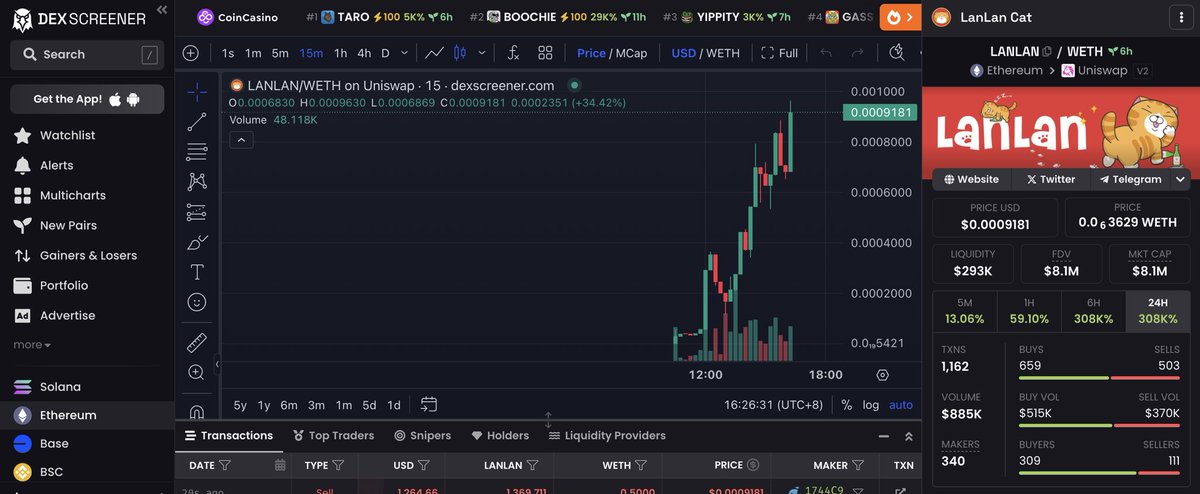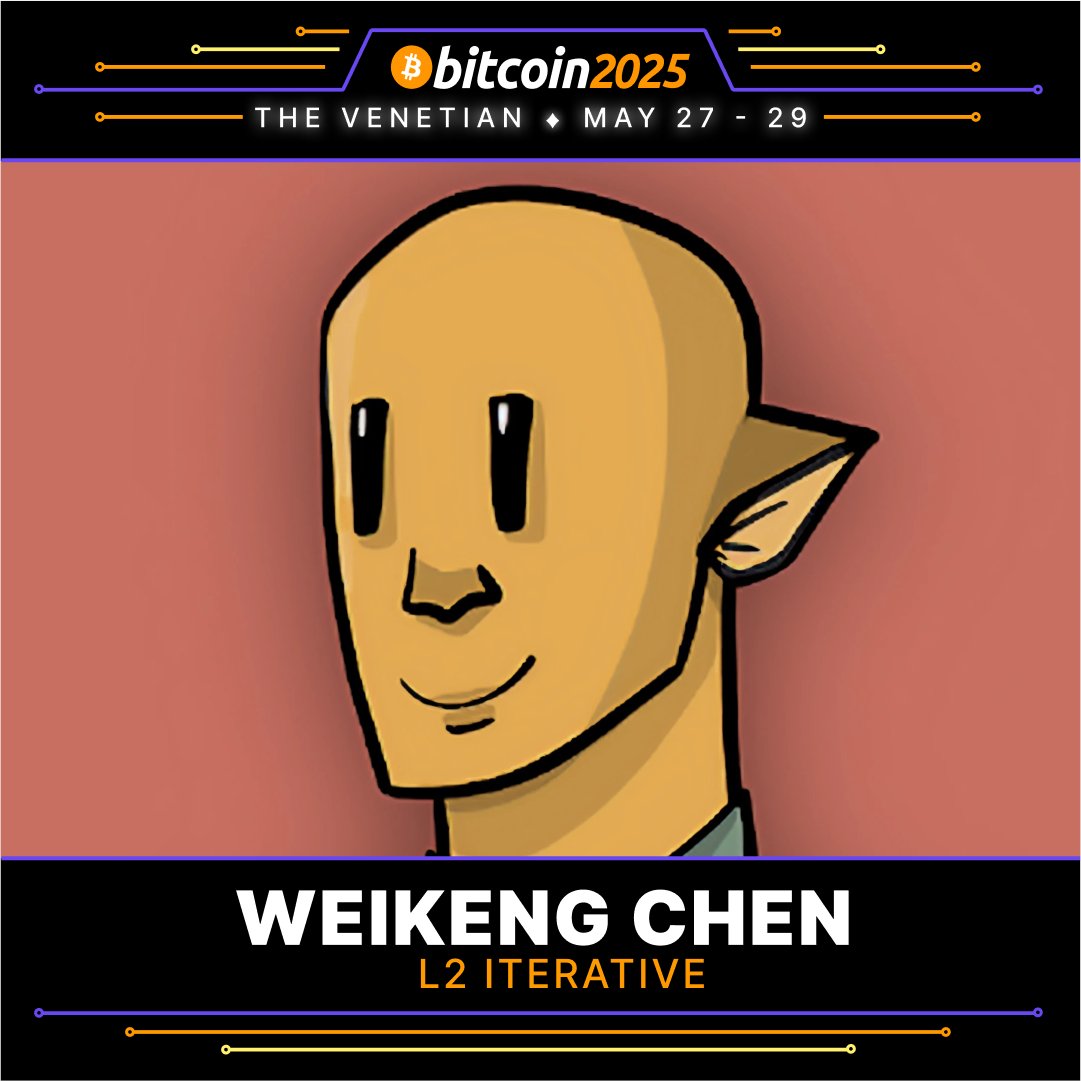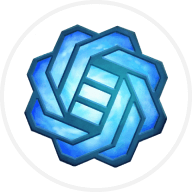
CAT
Precio de Simons Cat
$0,0000090790
+$0,00000
(-0,77 %)
Cambios en los precios de las últimas 24 horas

¿Qué opinas hoy sobre el precio de CAT?
Comparte lo que piensas usando el pulgar hacia arriba si crees que la moneda va a adoptar una tendencia alcista o hacia abajo si crees que va a adoptar una tendencia bajista.
Vota para ver los resultados
Aviso
El contenido social en esta página ("Contenido"), incluidos, entre otros, los tuits y las estadísticas proporcionadas por LunarCrush, proviene de terceros y se proporciona "tal cual" solo con fines informativos. OKX no garantiza la calidad o exactitud del Contenido, y el Contenido no representa las opiniones de OKX. No pretende proporcionar (i) asesoramiento o recomendación de inversión; (ii) una oferta o solicitud para comprar, vender o mantener activos digitales; o (iii) asesoramiento financiero, contable, legal o fiscal. Los activos digitales, incluidas las stablecoins y los NFT, implican un alto grado de riesgo y pueden fluctuar enormemente. El precio y el rendimiento de los activos digitales no están garantizados y pueden cambiar sin previo aviso.<br></br>OKX no proporciona recomendaciones de inversión o de activos. Debes considerar cuidadosamente si el trading o el holding de activos digitales es adecuado para ti a la luz de tu situación financiera. Consulta a tu asesor legal/fiscal/profesional de inversiones para preguntas sobre tus circunstancias específicas. Para obtener más información, consulta nuestros <a href="/help/terms-of-service">Términos de us</a>o y <a href="/help/risk-compliance-disclosure">Advertencia de riesgo</a> Al usar el sitio web de terceros ("Sitio web de terceros" o "TWP"), aceptas que el uso del TWP estará sujeto a los términos de TWP. Salvo que se indique expresamente por escrito, OKX y sus afiliados ("OKX") no están asociados de ninguna manera con el propietario u operador del TPW. Aceptas que OKX no es responsable de ninguna pérdida, daño ni cualquier otra consecuencia generada por tu uso del TPW. Ten en cuenta que usar un TWP puede generar una pérdida o reducción de tus activos. El producto puede no estar disponible en todas las jurisdicciones.
Información de mercado de Simons Cat
Cap. de mercado
La cap. de mercado se calcula multiplicando la oferta circulante de una moneda por su precio más reciente.
Cap. de mercado = Oferta circulante × Último precio
Cap. de mercado = Oferta circulante × Último precio
Oferta circulante
La cantidad total de una moneda que está disponible públicamente en el mercado.
Clasificación de la capitalización de mercado
La clasificación de una moneda en términos de valor de capitalización de mercado.
Máximo histórico
El precio más alto que una moneda ha alcanzado en su historial de trading.
Mínimo histórico
El precio más bajo que una moneda ha alcanzado en su historial de trading.
Cap. de mercado
$61,22M
Oferta circulante
6.749.783.055.124 CAT
74,99 % de
9.000.000.000.000 CAT
Clasificación de la capitalización de mercado
222
Auditorías
CertiK
Última auditoría: --
Alto 24 h
$0,0000093760
Bajo 24 h
$0,0000086040
Máximo histórico
$0,000069360
-86,92 % (-$0,00006)
Última actualización: 17 dic 2024
Mínimo histórico
$0,0000041460
+118,98 % (+$0,0000049330)
Última actualización: 9 abr 2025
Feed de Simons Cat
El siguiente contenido proviene de .

币圈小韭菜⌘🛠️
⚡️ ¡Acabo de ver a un gato taiwanés @LanLanCoin un poco feroz! $LANLAN comprobó que se trata de la veterana superestrella de emojis de Taiwán "Lanlan Cat", y la tendencia es bastante feroz
Se dice que T0 se apresurará a CAT con un valor de mercado actual de 7,7 millones, y la ambición oficial no es pequeña, gritando que será la "primera moneda gato en el círculo de las criptomonedas", comparando $CAT y $DOGE
Este gato es muy lindo, desde 2010 hasta la actualidad, se caracteriza por la pereza, la estupidez y un poco de lengua venenosa......
Este estilo de "luto" es bastante resonante, la IP está bien y los amigos a los que les gustan los gatos deben prestarle atención
🐾 Eché un vistazo al calor de la comunidad y estaba bien
Dyor
Mostrar original
54,74 mil
43

BcJames #Rug the Fiat(Op_cat BIP347)
op_cat se discutirá @ bitcoin 2025

Weikeng Chen | BIP-420 🐱
Estaré en Bitcoin 2025 @TheBitcoinConf hablando sobre OP_CAT si introducirá MEV en Bitcoin (miércoles 28 de mayo, 12:30 p.m.) con Andrew Poelstra, @p0stc4p0n3 y @GwartyGwart. El socio gerente de L2 Iterative, Kevin Lee, @klee_049, también estará en Bitcoin 2025.

5,74 mil
2
Calculador de CAT


Rendimiento del precio de Simons Cat en USD
El precio actual de Simons Cat es de $0,0000090790. En las últimas 24 horas, Simons Cat disminuyó un -0,77 %. Actualmente, su oferta circulante es de 6.749.783.055.124 CAT y su oferta máxima, de 9.000.000.000.000 CAT, con lo que su capitalización de mercado completamente diluida (FDMC) es de $61,22M. En este momento, Simons Cat ocupa el puesto número 222 en la clasificación por capitalización de mercado. El precio de Simons Cat/USD se actualiza en tiempo real.
Hoy
+$0,00000
-0,77 %
7 días
+$0,00000
-22,37 %
30 días
+$0,0000033030
+57,18 %
3 meses
+$0,00000
-19,07 %
Conversiones populares de Simons Cat
Última actualización: 21/05/2025, 11:45
| 1 CAT a USD | 0,0000090700 $ |
| 1 CAT a EUR | 0,0000080300 € |
| 1 CAT a PHP | 0,00050425 ₱ |
| 1 CAT a IDR | 0,14888 Rp |
| 1 CAT a GBP | 0,0000067600 £ |
| 1 CAT a CAD | 0,000012610 $ |
| 1 CAT a AED | 0,000033310 AED |
| 1 CAT a VND | 0,23558 ₫ |
Sobre Simons Cat (CAT)
La calificación proporcionada es una calificación agregada recogida por OKX de las fuentes proporcionadas y es solo para fines informativos. OKX no garantiza la calidad o exactitud de las calificaciones. No pretende proporcionar (i) asesoramiento o recomendación de inversión; (ii) una oferta o solicitud para comprar, vender o mantener activos digitales; ni (iii) asesoramiento financiero, contable, legal o fiscal. Los activos digitales, incluidas las stablecoins y las NFT, entrañan un alto grado de riesgo, pueden fluctuar enormemente e incluso perder su valor. El precio y el rendimiento de los activos digitales no están garantizados y pueden cambiar sin previo aviso. Tus activos digitales no están cubiertos por un seguro contra posibles pérdidas. Los rendimientos históricos no son indicativos de rendimientos futuros. OKX no garantiza ningún rendimiento, reembolso de capital o intereses. OKX no proporciona recomendaciones de inversión o de activos. Debes considerar cuidadosamente si el trading o la posesión de activos digitales es adecuado para ti a la luz de tu situación financiera. Consulta con tu asesor legal/fiscal/profesional de la inversión si tienes preguntas acerca de tus circunstancias específicas.
Mostrar más
- Sitio web oficial
- Explorador de bloques
Sobre los sitios web de terceros
Sobre los sitios web de terceros
Al usar el sitio web de terceros ("Sitio web de terceros" o "TWP"), aceptas que el uso del TWP estará sujeto a los términos de TWP. Salvo que se indique expresamente por escrito, OKX y sus afiliados ("OKX") no están asociados de ninguna manera con el propietario u operador del TPW. Aceptas que OKX no es responsable de ninguna pérdida, daño ni cualquier otra consecuencia generada por tu uso del TPW. Ten en cuenta que usar un TWP puede generar una pérdida o reducción de tus activos.
Preguntas frecuentes sobre Simons Cat
¿Cuál es el valor actual de 1 Simons Cat?
Actualmente, un Simons Cat vale $0,0000090790. Para obtener respuestas e información sobre las acciones de precios de Simons Cat, estás en el lugar correcto. Explora los últimos gráficos de Simons Cat y opera de manera responsable con OKX.
¿Qué es una criptomoneda?
Las criptomonedas, como Simons Cat, son activos digitales que operan sobre libros mayores (ledger) públicos llamados blockchains. Obtén más información sobre las monedas y tokens que se ofrecen en OKX y sus distintas características, como su precio y gráficos en tiempo real.
¿Cuándo se inventaron las criptomonedas?
A raíz de la crisis financiera de 2008, creció el interés por las finanzas descentralizadas. Bitcoin ofrecía una solución novedosa al ser un activo digital seguro en una red descentralizada. Desde entonces, también se han creado muchos otros tokens como Simons Cat.
¿Va a subir el precio de Simons Cat hoy?
Consulta nuestra página de predicción de precios de Simons Cat para ver los pronósticos de precios y determinar tus objetivos de valor.
Declaración de GEI
Las regulaciones ESG (Environmental, Social and Governance) para los criptoactivos tienen como objetivo abordar su impacto ambiental (por ejemplo, la minería intensiva en energía), promover la transparencia y garantizar prácticas éticas de gobernanza para alinear la industria de las criptomonedas con objetivos más amplios de sostenibilidad y sociales. Estas regulaciones fomentan el cumplimiento de normas que mitigan los riesgos y promueven la confianza en los activos digitales.
Detalles del activo
Nombre
OKcoin Europe LTD
Identificador de entidad legal relevante
54930069NLWEIGLHXU42
Nombre del criptoactivo
simons_cat
Mecanismo de consenso
simons_cat is present on the following networks: binance_smart_chain, solana.
Binance Smart Chain (BSC) uses a hybrid consensus mechanism called Proof of Staked Authority (PoSA), which combines elements of Delegated Proof of Stake (DPoS) and Proof of Authority (PoA). This method ensures fast block times and low fees while maintaining a level of decentralization and security. Core Components 1. Validators (so-called “Cabinet Members”): Validators on BSC are responsible for producing new blocks, validating transactions, and maintaining the network’s security. To become a validator, an entity must stake a significant amount of BNB (Binance Coin). Validators are selected through staking and voting by token holders. There are 21 active validators at any given time, rotating to ensure decentralization and security. 2. Delegators: Token holders who do not wish to run validator nodes can delegate their BNB tokens to validators. This delegation helps validators increase their stake and improves their chances of being selected to produce blocks. Delegators earn a share of the rewards that validators receive, incentivizing broad participation in network security. 3. Candidates: Candidates are nodes that have staked the required amount of BNB and are in the pool waiting to become validators. They are essentially potential validators who are not currently active but can be elected to the validator set through community voting. Candidates play a crucial role in ensuring there is always a sufficient pool of nodes ready to take on validation tasks, thus maintaining network resilience and decentralization. Consensus Process 4. Validator Selection: Validators are chosen based on the amount of BNB staked and votes received from delegators. The more BNB staked and votes received, the higher the chance of being selected to validate transactions and produce new blocks. The selection process involves both the current validators and the pool of candidates, ensuring a dynamic and secure rotation of nodes. 5. Block Production: The selected validators take turns producing blocks in a PoA-like manner, ensuring that blocks are generated quickly and efficiently. Validators validate transactions, add them to new blocks, and broadcast these blocks to the network. 6. Transaction Finality: BSC achieves fast block times of around 3 seconds and quick transaction finality. This is achieved through the efficient PoSA mechanism that allows validators to rapidly reach consensus. Security and Economic Incentives 7. Staking: Validators are required to stake a substantial amount of BNB, which acts as collateral to ensure their honest behavior. This staked amount can be slashed if validators act maliciously. Staking incentivizes validators to act in the network's best interest to avoid losing their staked BNB. 8. Delegation and Rewards: Delegators earn rewards proportional to their stake in validators. This incentivizes them to choose reliable validators and participate in the network’s security. Validators and delegators share transaction fees as rewards, which provides continuous economic incentives to maintain network security and performance. 9. Transaction Fees: BSC employs low transaction fees, paid in BNB, making it cost-effective for users. These fees are collected by validators as part of their rewards, further incentivizing them to validate transactions accurately and efficiently.
Solana uses a unique combination of Proof of History (PoH) and Proof of Stake (PoS) to achieve high throughput, low latency, and robust security. Here’s a detailed explanation of how these mechanisms work: Core Concepts 1. Proof of History (PoH): Time-Stamped Transactions: PoH is a cryptographic technique that timestamps transactions, creating a historical record that proves that an event has occurred at a specific moment in time. Verifiable Delay Function: PoH uses a Verifiable Delay Function (VDF) to generate a unique hash that includes the transaction and the time it was processed. This sequence of hashes provides a verifiable order of events, enabling the network to efficiently agree on the sequence of transactions. 2. Proof of Stake (PoS): Validator Selection: Validators are chosen to produce new blocks based on the number of SOL tokens they have staked. The more tokens staked, the higher the chance of being selected to validate transactions and produce new blocks. Delegation: Token holders can delegate their SOL tokens to validators, earning rewards proportional to their stake while enhancing the network's security. Consensus Process 1. Transaction Validation: Transactions are broadcast to the network and collected by validators. Each transaction is validated to ensure it meets the network’s criteria, such as having correct signatures and sufficient funds. 2. PoH Sequence Generation: A validator generates a sequence of hashes using PoH, each containing a timestamp and the previous hash. This process creates a historical record of transactions, establishing a cryptographic clock for the network. 3. Block Production: The network uses PoS to select a leader validator based on their stake. The leader is responsible for bundling the validated transactions into a block. The leader validator uses the PoH sequence to order transactions within the block, ensuring that all transactions are processed in the correct order. 4. Consensus and Finalization: Other validators verify the block produced by the leader validator. They check the correctness of the PoH sequence and validate the transactions within the block. Once the block is verified, it is added to the blockchain. Validators sign off on the block, and it is considered finalized. Security and Economic Incentives 1. Incentives for Validators: Block Rewards: Validators earn rewards for producing and validating blocks. These rewards are distributed in SOL tokens and are proportional to the validator’s stake and performance. Transaction Fees: Validators also earn transaction fees from the transactions included in the blocks they produce. These fees provide an additional incentive for validators to process transactions efficiently. 2. Security: Staking: Validators must stake SOL tokens to participate in the consensus process. This staking acts as collateral, incentivizing validators to act honestly. If a validator behaves maliciously or fails to perform, they risk losing their staked tokens. Delegated Staking: Token holders can delegate their SOL tokens to validators, enhancing network security and decentralization. Delegators share in the rewards and are incentivized to choose reliable validators. 3. Economic Penalties: Slashing: Validators can be penalized for malicious behavior, such as double-signing or producing invalid blocks. This penalty, known as slashing, results in the loss of a portion of the staked tokens, discouraging dishonest actions.
Mecanismos de incentivos y comisiones aplicables
simons_cat is present on the following networks: binance_smart_chain, solana.
Binance Smart Chain (BSC) uses the Proof of Staked Authority (PoSA) consensus mechanism to ensure network security and incentivize participation from validators and delegators. Incentive Mechanisms 1. Validators: Staking Rewards: Validators must stake a significant amount of BNB to participate in the consensus process. They earn rewards in the form of transaction fees and block rewards. Selection Process: Validators are selected based on the amount of BNB staked and the votes received from delegators. The more BNB staked and votes received, the higher the chances of being selected to validate transactions and produce new blocks. 2. Delegators: Delegated Staking: Token holders can delegate their BNB to validators. This delegation increases the validator's total stake and improves their chances of being selected to produce blocks. Shared Rewards: Delegators earn a portion of the rewards that validators receive. This incentivizes token holders to participate in the network’s security and decentralization by choosing reliable validators. 3. Candidates: Pool of Potential Validators: Candidates are nodes that have staked the required amount of BNB and are waiting to become active validators. They ensure that there is always a sufficient pool of nodes ready to take on validation tasks, maintaining network resilience. 4. Economic Security: Slashing: Validators can be penalized for malicious behavior or failure to perform their duties. Penalties include slashing a portion of their staked tokens, ensuring that validators act in the best interest of the network. Opportunity Cost: Staking requires validators and delegators to lock up their BNB tokens, providing an economic incentive to act honestly to avoid losing their staked assets. Fees on the Binance Smart Chain 5. Transaction Fees: Low Fees: BSC is known for its low transaction fees compared to other blockchain networks. These fees are paid in BNB and are essential for maintaining network operations and compensating validators. Dynamic Fee Structure: Transaction fees can vary based on network congestion and the complexity of the transactions. However, BSC ensures that fees remain significantly lower than those on the Ethereum mainnet. 6. Block Rewards: Incentivizing Validators: Validators earn block rewards in addition to transaction fees. These rewards are distributed to validators for their role in maintaining the network and processing transactions. 7. Cross-Chain Fees: Interoperability Costs: BSC supports cross-chain compatibility, allowing assets to be transferred between Binance Chain and Binance Smart Chain. These cross-chain operations incur minimal fees, facilitating seamless asset transfers and improving user experience. 8. Smart Contract Fees: Deployment and Execution Costs: Deploying and interacting with smart contracts on BSC involves paying fees based on the computational resources required. These fees are also paid in BNB and are designed to be cost-effective, encouraging developers to build on the BSC platform.
Solana uses a combination of Proof of History (PoH) and Proof of Stake (PoS) to secure its network and validate transactions. Here’s a detailed explanation of the incentive mechanisms and applicable fees: Incentive Mechanisms 4. Validators: Staking Rewards: Validators are chosen based on the number of SOL tokens they have staked. They earn rewards for producing and validating blocks, which are distributed in SOL. The more tokens staked, the higher the chances of being selected to validate transactions and produce new blocks. Transaction Fees: Validators earn a portion of the transaction fees paid by users for the transactions they include in the blocks. This provides an additional financial incentive for validators to process transactions efficiently and maintain the network's integrity. 5. Delegators: Delegated Staking: Token holders who do not wish to run a validator node can delegate their SOL tokens to a validator. In return, delegators share in the rewards earned by the validators. This encourages widespread participation in securing the network and ensures decentralization. 6. Economic Security: Slashing: Validators can be penalized for malicious behavior, such as producing invalid blocks or being frequently offline. This penalty, known as slashing, involves the loss of a portion of their staked tokens. Slashing deters dishonest actions and ensures that validators act in the best interest of the network. Opportunity Cost: By staking SOL tokens, validators and delegators lock up their tokens, which could otherwise be used or sold. This opportunity cost incentivizes participants to act honestly to earn rewards and avoid penalties. Fees Applicable on the Solana Blockchain 7. Transaction Fees: Low and Predictable Fees: Solana is designed to handle a high throughput of transactions, which helps keep fees low and predictable. The average transaction fee on Solana is significantly lower compared to other blockchains like Ethereum. Fee Structure: Fees are paid in SOL and are used to compensate validators for the resources they expend to process transactions. This includes computational power and network bandwidth. 8. Rent Fees: State Storage: Solana charges rent fees for storing data on the blockchain. These fees are designed to discourage inefficient use of state storage and encourage developers to clean up unused state. Rent fees help maintain the efficiency and performance of the network. 9. Smart Contract Fees: Execution Costs: Similar to transaction fees, fees for deploying and interacting with smart contracts on Solana are based on the computational resources required. This ensures that users are charged proportionally for the resources they consume.
Comienzo del periodo incluido en la declaración
2024-04-20
Fin del periodo incluido en la declaración
2025-04-20
Informe energético
Consumo de energía
75.92137 (kWh/a)
Fuentes y metodologías de consumo de energía
The energy consumption of this asset is aggregated across multiple components:
To determine the energy consumption of a token, the energy consumption of the network(s) binance_smart_chain, solana is calculated first. Based on the crypto asset's gas consumption per network, the share of the total consumption of the respective network that is assigned to this asset is defined. When calculating the energy consumption, we used - if available - the Functionally Fungible Group Digital Token Identifier (FFG DTI) to determine all implementations of the asset of question in scope and we update the mappings regulary, based on data of the Digital Token Identifier Foundation.
Calculador de CAT


















